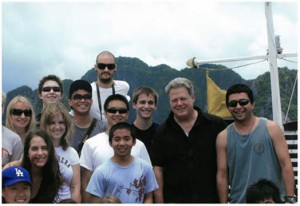By Dan Edelen
“As globalization continues to expand, and we all become part of one big global village, the importance of knowing about and respecting the diversity of other cultures will increase exponentially,” says James M. Steele Jr. ’65. “The degradation of the environment is tied to this, since increased population and development will increase its destruction.”

Prof. James Steele ’65 and his students in the semester-long summer abroad in Asia take a boat trip down the Li River near Guilin, China.
Professor of architecture at University of Southern California, Steele teaches and studies how other cultures have incorporated environmental strategies since architecture began, calling on his experiences worldwide. Others depend on his global perspective—and his knowledge of the works of others. Recently, Steele received appointment to the UNESCO Scientific Committee to save and preserve Hassan Fathy’s New Gourna Village in Luxor, Egypt.
Steele is known for his seminal work on Hassan Fathy, the Egyptian architect who championed sustainable building methods and community-based, traditional design. And Steele’s book, Architecture Today (1997), is deemed a modern classic.
He has also written or edited more than 38 other books, including examinations of architecture in developing nations, and several overviews of architectural design, which have received critical acclaim, including the Phi Kappa Phi Award and the AIA Publications Award.
An English graduate, Steele was mentored by Johannes Gaertner, professor of foreign languages and art history, who steered his heart toward history and worldwide locales, and Clarence Carter, artist in residence from 1967-71, who lit the young man’s artistic flame. On the basis of four drawings made under Carter’s guidance, Steele gained acceptance to several Ivy League architectural schools, including Penn.
“I have always been aware of the role a transformative teacher can play, and not to write off anyone,” Steele says, with a nod to Cuban architect Mario Romañac,h “who turned me around during my first year at Penn.” Steele says that because of Romañach he graduated with a Bronze Medal, second in his class, and received a scholarship to join Louis Kahn’s graduate course.
With the influence of caring mentors always with him, Steele headed to Saudi Arabia when architectural work in America withered in the early 1980s recession. At King Faisal (now Dammam) University, Steele followed the rules that forbade outside design work for teachers and instead honed his pedagogy and writing.
His Middle East experience did more than turn Steele’s passion to teaching. One man would change the direction of his career and his life—Hassan Fahay.
“Fathy opened me up to an entirely different viewpoint, which can now be categorized as sustainable architecture,” Steele says. “For him, it was really just an awareness of the instinctual wisdom of our ancestors. Traditional, or whatever term you want to use for the architecture of indigenous peoples, is typically approached as quaint, picturesque, and ultimately irrelevant. Fathy taught me that it contains important lessons for us all, if only we can overcome our cultural prejudices, arrogance, and ethnic myopia.”
Steele’s detailed study on Fathy attracted international acclaim and took him to London, where he taught at the Prince of Wales’ School of Architecture, Magdelen College, Oxford. Prince Charles thanked him personally for his skills. Texas Tech then called, where Steele won the Tau Sigma Delta Award for Excellence in Teaching.
On the strength of the Fathy monograph, Steele was recruited by the University of Southern California for a historian position. He completed a doctorate in policy planning and development there.
Steele’s work overseas made him a natural choice as a diversity specialist. With a 40 percent Asian student body at USC, Steele explored developing a program for studies in Asia. In 1998, he founded and continues to lead the semester-long summer program based in Malaysia at the Kuala Lumpur Studio.
“We typically have about 20 students, and we team up with an equal number from the University of Malaya,” he says. The students conduct community-service projects such as building schools in impoverished rural villages throughout Southeast Asia, primarily in Cambodia, and they travel to Japan, China, Vietnam, Cambodia, and Singapore, “to gain an appreciation of the entirety and diversity of the Asian world.”
“Americans are notoriously insular,” Steele says, “so I have tried to expose as many students as possible to other cultures.” He has opened alternative architectural ideas to hundreds.
Lafayette students now have the opportunity to select a minor in architecture studies, which was established in 2007. And they benefited from Steele’s Landis Lecture in 2008 on sustainability considerations incorporated in traditional designs and the integration of engineering and liberal arts as embodied in architecture.
Steele has written two books about his experiences teaching in Asia, Sustainable Architecture: Principles, Paradigms and Case Studies and Ecological Architecture: A Critical History. And he is at work on books about contemporary Japanese architecture and monographs on architects Romañach, Jafar Tukan of Jordan, Ken Yeang of Malaysia, and Californian Ray Kappe.

1 Comment
Comments are closed.